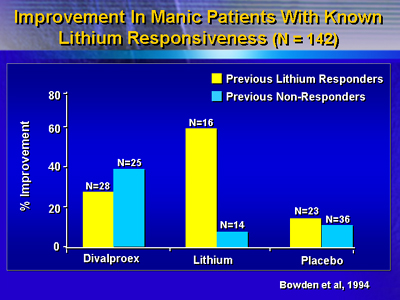|
The complexity of bipolar disorder suggests
that combination therapy will lead to more effective treatment
of this disorder. Combination therapy may lead to synergistic
mechanisms of action. For example, clinical and basic research
indicate the action of lithium and the anticonvulsant, divalproex,
act synergistically in their beneficial effects. Greater compliance
is reported in patients receiving combination therapy with lithium
plus divalproex compared to monotherapy with either drug. Other
treatments for bipolar disorder are also discussed.
The great majority of data on the efficacy of putative mood
stabilizers in bipolar disorder is derived from monotherapy
studies. The research community and the U.S. Food and Drug
Administration (FDA) prefer monotherapy trials. Monotherapy
trials have provided valuable information on individual drugs.
However, the complexity of bipolar disorder suggests that
combination therapy will lead to more effective treatment
of this disorder.
In actual practice, most bipolar patients receive more than
one medication. Combination therapy allows the clinician to
target different symptom clusters such as cognitive, psychotic
or increased psychomotor activity in mania. In addition, combinations
of drugs may lead to synergistic mechanisms of action.
Lithium has been the standard treatment for patients with
bipolar disorder. Current research indicates the most effective
mood stabilizers to use for prophylactic treatment of bipolar
disorder are lithium, divalproex, lamotrigine, carbamazepine
and olanzapine. Prophylactic treatment of rapid cyclers is
achieved with lamotrigine, divalproex, carbamazepine and lithium.
However, for rapid cyclers, prophylaxis of depressive recurrence
with lithium is preferred over prophylaxis with antidepressants.
Breakthrough depression is best treated with lithium, lamotrigine,
olanzapine. Some reports indicate successful treatment of
breakthrough depression with divalproex, while others do not.
Dr. Goodwin mentioned the importance of realizing that many
signal transduction pathways may be involved in the biological
cause of bipolar disorder. As a result, not all bipolar patients
are the same. For example, some manic patients may respond
to lithium while others may respond to depakote.

New research investigating the mechanism of action of lithium
and the anticonvulsants suggest that lithium and the anticonvulsant,
divalproex, act synergistically in their beneficial effects.
This would further suggest that combination therapy with lithium
and divalproex is more effective when used together. The dose
of each drug used is below the dose used in monotherapy. This
information supports the recent report that compliance is
greater in patients receiving combination therapy with lithium
plus divalproex compared to monotherapy with either drug.
|